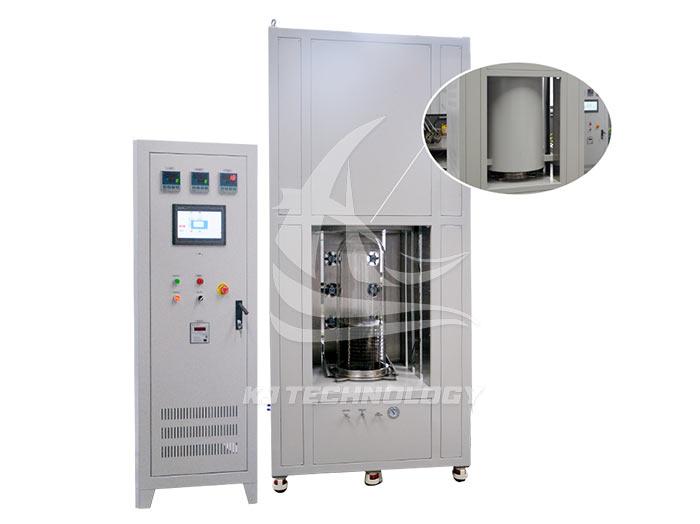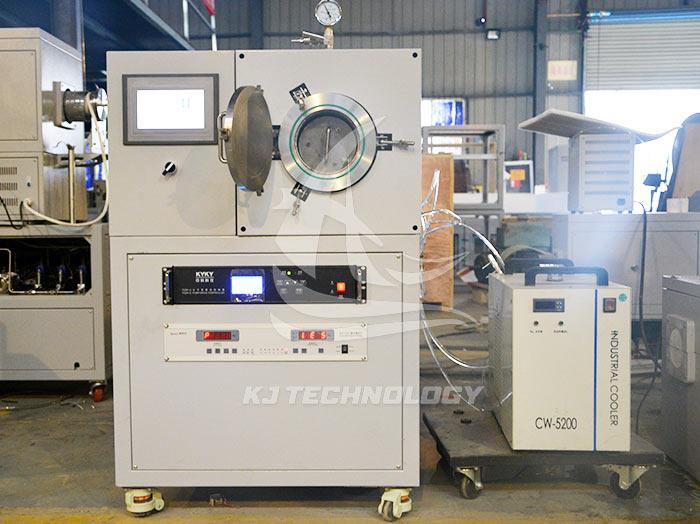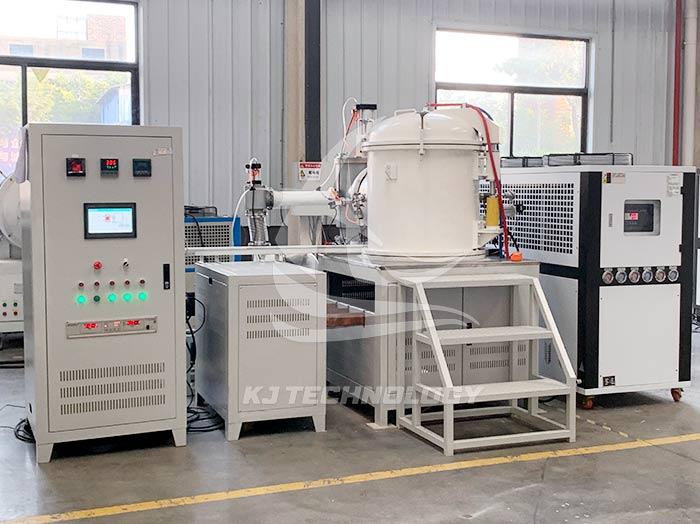Working principle of vacuum degreasing furnace
 08-22-2025 Author: KJ technology
08-22-2025 Author: KJ technology
The vacuum degreasing furnace achieves efficient and pollution-free removal of organic binders in materials by creating a low-pressure environment and combining precise temperature control. The working principle involves the synergistic effect of vacuum system, heating system, gas control system, and process control logic. The following is a detailed step-by-step analysis:
1. Core system composition
vacuum system
Function: Maintain low pressure environment inside the furnace, reduce the boiling point of organic matter, and inhibit oxidation reactions.
Key equipment:
Mechanical pump: roughly evacuate to below 10 ³ Pa.
Roots pump: Accelerated pumping during the medium vacuum stage (10 ³ -10 ⁻¹ Pa).
Diffusion pump/molecular pump: achieve deep degreasing in the high vacuum stage (10 ⁻¹ -10 ⁻⁴ Pa).
Vacuum gauge: Real time monitoring of pressure, feedback to the control system to adjust the pumping rate.
heating system
Function: Provide controllable heat source, gradually increase temperature to promote the volatilization of adhesive.
Key equipment:
Resistance heating elements (such as molybdenum wire, graphite): evenly distributed in the furnace, with adjustable heating rate.
Infrared heating tube: used for local rapid heating (such as degreasing the surface of ceramic green bodies).
Thermocouple/infrared thermometer: Real time monitoring of temperature.
Gas control system
Function: Introduce inert gases (such as argon) or reactive gases (such as hydrogen, nitric acid vapor) to optimize the degreasing process.
Key equipment:
Quality flowmeter: precise control of gas flow rate.
Gas mixing device: used for catalytic degreasing (such as mixing nitric acid with nitrogen).
Pressure sensor: monitors the air pressure inside the furnace and maintains the set value in conjunction with the vacuum pump.
Process control system
Function: Integrate temperature, pressure, and time parameters to achieve automated degreasing programs.
Key equipment:
PLC controller: stores multiple process curves and supports real-time modification.
Human Machine Interface (HMI): displays operational status, alarm information, and historical data.
Data logger: Traces production parameters for each batch and meets certification requirements such as ISO/TS 16949.
2. Working principle in stages
Stage 1: Loading and Pre Vacuum Extraction
Operation: Load the blank (such as MIM injection parts, ceramic blank) into the furnace, close the furnace door and seal it.
Vacuum system operation:
Start the mechanical pump and roughly pump to below 10 ³ Pa.
Roots pump intervention, quickly pumping to 10 ⁻¹ Pa.
Start the diffusion pump/molecular pump and enter the high vacuum stage (10 ⁻ ³ Pa).
Purpose: To eliminate air inside the furnace and prevent material oxidation during subsequent heating.
Stage 2: Low temperature degreasing (adhesive volatilization)
Temperature control:
Heat up to 150-450 ℃ (adjusted according to the type of adhesive).
Typical adhesive degreasing temperature range:
Paraffin wax: 120-200 ℃
Polyoxymethylene (POM): 180-220 ℃
Polyethylene (PE): 250-350 ℃
Vacuum system operation:
Maintain high vacuum (10 ⁻ ³ Pa) and lower the boiling point of the binder.
The wax trap is activated to condense and recover volatile organic compounds.
Gas control (optional):
Catalytic degreasing: introducing nitric acid vapor to accelerate the decomposition of POM into formaldehyde and formic acid.
Hydrogen degreasing: Fill with hydrogen to prevent oxidation of magnetic materials (such as neodymium iron boron).
Stage 3: Medium temperature degreasing (residue removal)
Temperature control:
Heat up to 450-600 ℃, hold for 1-4 hours, and decompose the thermal decomposition residue of the binder (such as carbon black).
Vacuum system operation:
Switch to medium vacuum (10 ⁻¹ -10 Pa) to promote residue evaporation.
Pressure pulse cleaning: alternate filling of argon gas to form a permeation suction cycle, removing residues in the deep hole.
Gas control:
A small amount of oxygen is introduced, and the residual carbon dioxide is discharged as CO ₂ (strict control of oxygen is required to prevent material oxidation).
Stage 4: High temperature sintering (optional)
Temperature control:
Heat up to the sintering temperature (such as 1400-1500 ℃ for hard alloys and 1600-1800 ℃ for ceramics) and hold for 0.5-2 hours.
Vacuum system operation:
Maintain high vacuum to prevent material evaporation or reaction at high temperatures.
Some processes require argon gas to be filled for atmosphere protection sintering.
Purpose: To achieve material densification and improve properties such as density and hardness.
Stage 5: Cooling and discharging
Cooling method:
Natural cooling: suitable for non rapid cooling materials (such as ceramics).
Forced air cooling/air cooling: filled with argon gas for circulating cooling, reducing time consumption.
Vacuum system operation:
Break the vacuum to atmospheric pressure and open the furnace door to retrieve the material.
Notes:
Avoid thermal stress cracking caused by rapid cooling.
Magnetic materials need to be cooled in an inert atmosphere to prevent oxidation.
3. Key technical principles
Low pressure boiling point lowering effect
Application: POM has a boiling point of 180 ℃ at 1 atm and drops to 120 ℃ at 10 ⁻ Pa, improving the degreasing efficiency.
Penetration suction degreasing mechanism
Principle: During pressure pulse cleaning, argon gas penetrates the pores of the billet, forming a pressure gradient that drives the residue to migrate towards the surface, and then it is removed by a vacuum pump.
Effect: The removal rate of residue in deep holes has been improved compared to traditional methods.
Advantages: Reduced reaction activation energy, faster degreasing rate than thermal decomposition.
4. Summary of Application Scenarios and Advantages
Powder metallurgy: MIM stainless steel, titanium alloy, avoiding oxidation, better dimensional accuracy, and higher density.
Ceramic materials: zirconia, silicon nitride, reduce closed pores, low porosity, and improve bending strength.
Magnetic materials: neodymium iron boron, samarium cobalt, no need for acid washing and oxygen removal, stable magnetic properties.
Biomaterials: Hydroxyapatite, PLA scaffolds, low-temperature degreasing to prevent biomolecule degradation and maintain activity.
3D printed ceramics: photo cured alumina to avoid thermal stress cracking.
The vacuum degreasing furnace achieves efficient, controllable, and pollution-free material degreasing process through precise control of vacuum degree, temperature, and gas environment, becoming an indispensable key equipment in the high-end manufacturing field.








